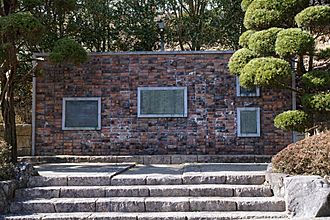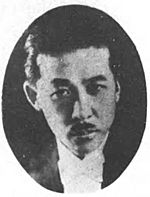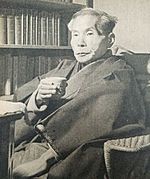Akatombo facts for kids
Quick facts for kids Akatombo |
|
|---|---|

Monument to the song in the hometown of the poet Rofū Miki (Tatsuno, Hyōgo)
|
|
| English |
|
| Native name | 赤とんぼ |
| Written | 1921 |
| Text | by Rofū Miki |
| Language | Japanese |
| Melody | by Kosaku Yamada |
| Composed | 1927 |
"Red Dragonfly" (Japanese: 赤とんぼ, Hepburn: Akatonbo) (also called Akatombo or Aka Tombo) is a very famous Japanese children's song. It was written by Rofū Miki as a poem in 1921. Later, Kosaku Yamada composed the music for it in 1927.
The song tells a story about a Japanese red dragonfly seen at sunset. It brings back warm memories of being a baby, carried on an older sister's shoulder. Many people in Japan love this song because it reminds them of their childhood and home.
Contents
The Story Behind the Song
The poem "Red Dragonfly" is like a memory from someone's childhood. It talks about being a baby and riding on the back of an older sister or a kind helper. The person singing the song now misses this person. This "mother figure" got married when she was 15 years old. She moved far away and stopped sending news back to the village.
Rofū Miki's Childhood
The poet, Rofū Miki (1889–1964), had a similar experience. His own mother was also married at age 15. When Miki was five years old, his parents divorced. His mother moved away and never came back. Miki was then raised by his grandfather.
When Miki was 12, he wrote the last three lines of the poem. This was ten years before the full poem was published:
Little red dragonfly
Resting, waiting
On the end of a bamboo pole
Miki's mother, Kata Midorikawa, became an important person in the women's rights movement in Japan. She passed away at 91. Her gravestone has the words "At rest here, little dragonfly’s mother." Miki himself died two years later, at age 76.
Why the Song is Special
Jennifer Milioto Matsue, who studies Japanese music, wrote about "Akatombo" in 2016. She said the song uses the image of red dragonflies to bring back feelings of the past. It also reminds people of their old country home, called furusato.
The song makes people feel a longing for all "mothers" from their childhoods. It also shows the sadness people feel when loved ones move away. This was a common feeling in the early 1900s when many people moved from the countryside to cities in Japan.
The Music of Akatombo
<score vorbis=1 midi=1>{ \set Staff.midiInstrument = #"voice oohs" \key es \major \tempo "Lento" 4=60 \time 3/4 \relative bes { bes8 es es4. f8 | g bes es( c) bes4 | c8 es, es4 f | g2 r4 |\break g8 c bes4. c8 | es c bes( c) bes( g) | bes g es( g) f( es) | es2 r4 \bar "|." } \addlyrics { ioú - ya -- kē ko -- ya -- kè no ā -- kǎ to -- m -- bo o -- wā -- rē -- tē mi -- ta nó wà i -- cih nó hì ka } }</score>

The composer, Kosaku Yamada (1886–1965), was a close friend of Rofū Miki. He took Miki's 1921 poem and created the beautiful music for it in 1927.
Creating Dōyō Songs
In the 1920s, Yamada and other respected Japanese composers wanted to make better songs for children. The old children's songs from the government were often boring, patriotic, or just taught lessons. These new songs were called dōyō. They were not just for kids; they were also like art songs for adults.
Yamada published a collection called 100 Children's Songs by Kosaku Yamada in 1927. This book helped create a lasting style of Japanese music.
The Melody's Special Sound
The melody of "Akatombo" uses a special kind of musical scale. It's called yonanuki (pronounced "yo-na-noo-kee"). This is a major scale that leaves out the fourth and seventh notes. This scale became very important in Japan in the early 1900s. It sounded good to both Japanese and Western ears.
Yamada's music from this time was special because it blended Japanese and Western sounds well. Many other composers struggled with this. His music often felt more like traditional Japanese melodies. Jennifer Milioto Matsue described "Akatombo" as having a simple but emotional singing part. The piano music is also simple and supports the beautiful words.
Yamada was inspired by German composers like Robert Schumann. The main tune of "Akatombo" sounds a bit like a theme in one of Schumann's piano pieces from 1853.
"Akatombo" is one of three songs Yamada wrote using Miki's poems. It's interesting to note that Miki and Yamada both died on December 29th, exactly one year apart.
Why Akatombo is So Popular
"Akatombo" is one of the most loved songs in Japan.
- In 1989, a survey by the NHK (Japan's public broadcaster) found that "Akatombo" was the most popular song in the whole country.
- In 2007, the Japanese government's Agency for Cultural Affairs put it on their list of 100 Japanese Songs that are widely loved.
- In 2008, the Japan Mint even made special "Aka Tombo" coins to honor the song!
- There is a large monument to the song in Tatsuno, Hyōgo, which is the hometown of the poet Rofū Miki.
- In many Japanese cities, the song is played over outdoor speakers as part of the "5 o'clock chimes." This marks the end of the day.
Famous Performances
Many musicians have performed and recorded "Akatombo."
- French flautist Jean-Pierre Rampal recorded the song with harpist Lily Laskine in 1978. He also played a longer version with Japanese koto instruments in 1982.
- Pianist and composer Haruna Miyake included a version of "Akatombo" in her 1981 piano collection. She wrote this variation when she was just twelve years old!
- Violinist Anne Akiko Meyers played an arrangement for violin and piano on her 1994 CD.
- British flautist William Bennett recorded the song with pianist Clifford Benson in 1995.


